I'm also in zone 6A (Massachusetts, USA), and have something that works perfectly for me.
It is vinca, also called periwinkle. I think mine is vinca minor, but there are a number of varieties, so it might be something else in the same family.
As for your criteria:
- It thrives well in all levels of sun. Some references say it needs mostly shade, but mine spreads out everywhere. It's happy in deep darkness under and around trees and bushes, however it also grows without any problems at the edge of the gardens where the sun shines at least six hours a day.
- It easily spreads in large areas, so the size of your plot is not a problem. Even though it's a vine, it roots from sections along the stem, so the leaves cover most of the brown branches, thus giving a groundcover carpet look. Mine happily grow alongside, under and around evergreens, rhododendrons, hostas, lillies of the valley, peonies, astilbe, daylilies, lamb's ears, other perennials, including bulb plants, and all manner of annuals. It also co-exists with other spreading plants, like things in the mint family. I don't know about the blueberry bushes, so I'll leave that to someone else to answer for you.
- It only reaches about four inches tall at the very most, and that's usually during flowering time. In general it's more like three, but most of it lies flat along the ground. Therefore, it never needs to be mowed.
- We don't really give it any care. It gets watered at the same intervals as the plants in the same area. We don't fertilize, mulch, or otherwise treat the soil. It's fine in the area where the soil tends to be very moist and clay-like. That includes both sun and shade. In one of our other areas, it's in loose dirt in full sun under an overhang with a gutter, so that area gets easily dried out. I will say it grows better in the more moist area, but it's pretty forgiving.
- It's a very reliable perennial, so you wouldn't have to worry about that part. Although the leaves lose a bit of their green color in the winter, they're never brown enough to appear dead, and they becomes dark green early in the spring.
- It's a vine, so it reaches out in any direction it can. It also bunches up if it has no place to go. We've been here three years and have never needed to prune any areas of the main carpet. The vines along the border, like where the young squirrel is in one of my pictures, will reach out between two and three inches at the most over the course of a year. It's very easy to break, though, and is shallow-rooted, so if it starts to get in your way, you can pick or cut off the ends, or pull entire vines out, including the roots. The other thing I do is just turn the branch around and tuck it back into the larger area. It will re-root that way, making it even more care-free. Speaking of shallow roots, it transplants very easily. As long as it's not actively flowering, I pull pieces up and plant them in my window boxes. With some steady watering they take hold quickly and, after creating a blanket around my other flowers, I can train them to grow over the edge and become a trailing vine. (As I said, it grows slowly, so if you want a long training vine in a hurry, it's not the best choice. I know you didn't ask about this part. I just added it to show its versatility.)
- It can definitely take being walked on. We keep it under our bird feeders and don't think twice about stomping on it when feeding the birds. Chipmunks, squirrels, bunnies, skunks, opossums, raccoons and occasional passing young bears also trample it, but it doesn't suffer. It pops back up within a day or two. It also has no problem handling heavy snow and ice. You didn't mention it, but in case you're wondering, none of the backyard visitors eat it. It's also a safe spot for chipmunks and squirrels to hide. We have a rabbit that breeds under the rhododendron, and when the babies venture out, they use the vinca for cover.
- It grows along the base of our stone wall border, but doesn't really climb it. You mentioned you'd prefer a different plant there anyway.
According to No Fail Groundcovers vinca's a good choice. It also has information about pachysandra, and Boston Ivy. In fact, Boston Ivy may even be a good choice for you because it specifically likes full sun. I can't tell you from experience, because I haven't grown it, but I think it's definitely worth checking it out.
Additional information about vinca can be found here and here.
Edit:
Above the vinca pictures in the original answer, I added some that bloomed in May. They're from all over my yard, in sun, part sun, and shade. Some are out in the open; one is under a blossoming bleeding heart which is under a rhododendron; and one is under some miscellaneous plant debris left over from last year which I didn't clean up! The only two that are not mine had been in the original answer, with links to their sources.
All of the pictures have been made smaller so as not to take up too much room. Click on them for larger, closer views.
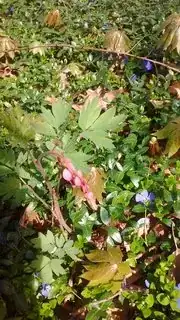
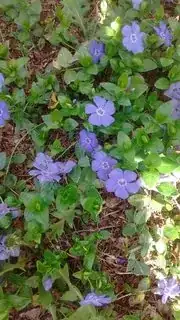

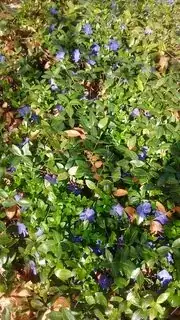
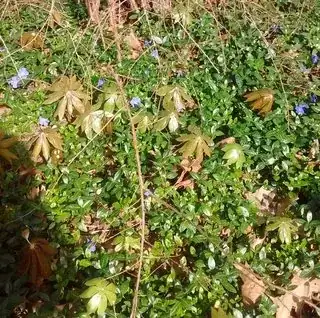
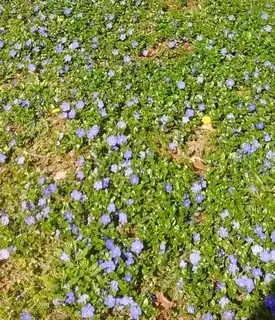
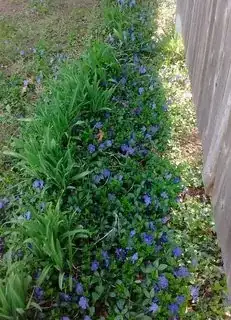

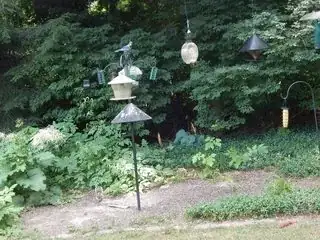
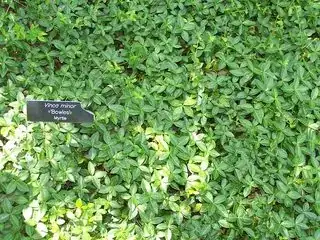 Source
Source 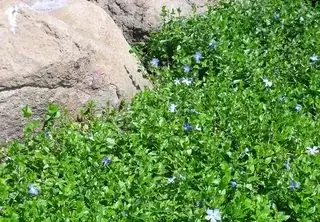 Source
Source










